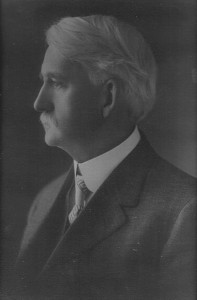Talented Tuesday: Edward B. Payne Still Quoted

McMurray Family (Click for Family Tree)
Edward Biron Payne (1847-1923) prided himself on his words, whether spoken or written. Trained as a minister, he was a powerful speaker for first the Congregational Church, then the Unitarians, and finally as a Christian Socialist and learned man. He was a powerful writer as well, and his writings and activities are still referred to, even today.
A 2012 book, Downwardly Mobile: The Changing Fortunes of American Realism, by Andrew Lawson, Oxford University Press, 2012, mentions Edward B. Payne’s criticism (‘criticism’ here used with the meaning of “analysis,” not a disapproval) of the poem by Edwin Markham called, “The Man with the Hoe.” As discussed in previous posts on this subject (see links below), Payne’s article was actually concerned with social as well as literary criticism of the poem, rather than his own thoughts on the work. In his recent book, Lawson quotes Payne as writing,
“[t]he clergy made the poem their text, platform orators dilated upon it, college professors lectured upon it, debating societies discussed it, schools took it up for study.”
This was all true, as in 1899, when the poem was published, there was great economic and social disparity in America, and it began to be discussed more loudly.
Just as today.
In Downwardly Mobile, Lawson mentions the 1896 Presidential election, in which William Jennings Bryan was defeated because he was a Democrat-Populist. There had been a terrible depression in the US- the ‘Panic of 1893’- and, as Bryan was quoted in the book, “The extremes of society are being driven further and further apart.” Ambrose Bierce even used the term, “class hatred” when referring to the feelings of the nation as the poem brought the covered-up inequality of our society to the public for large discussion.
In “The ‘Hoe Man’ On Trial,” published by Edward B. Payne in The Arena, we can see our country today reflected in many other comments made in those discussions of 1899. Payne’s article distills both sides of the conversation- er, often ‘argument’- and shows us the context of those times.
Payne’s article itself is not totally unbiased- it was, after all, printed in a magazine dedicated to addressing social and ethical dilemmas of the day. As a journalist, he did lay out the facts of both viewpoints, and left much of the analysis up to the reader. Payne was a Socialist- declared as such on the voter rolls for a few years, and he devoted his worklife to helping people better themselves, rather than giving them a handout. He always emphasized “cooperation” rather than “competition,” with the idea that more would be provided for if we all worked together.
Edward B. Payne struggled himself- after all, a minister was not a highly paid profession (he would be sickened at the wealth of today’s big church evangelists), and he had to retire from the ministry due to health reasons, plus reasons of changed ideology. Thereafter he made his living by lecturing and writing, neither of which made him a wealthy man. He worked long past normal retirement age, and his meager Civil War invalid pension of $6 per month granted in 1902 at age 55 likely made a huge difference in whether or not the rent could be paid.
“History repeats itself” as they say, and economy and society have their own repeated cycles. Edward B. Payne would most likely be saddened by the obstacles that we still face in our society, more than a century after the “Hoe Man” became famous, as well as infamous. In “the next world” or wherever he is, however, Edward probably would smile to know that his writings on the subject still matter, that scholars still read his work, and that his talented words still bring something to the conversation.
Notes, Sources, and References:
- Downwardly Mobile: The Changing Fortunes of American Realism, by Andrew Lawson, Oxford University Press, 2012, page 130.
- “The ‘Hoe Man’ On Trial”, The Arena, Vol. XXII, No. 1, July, 1899. pp. 17-24. https://archive.org/stream/ArenaMagazine-Volume22/189907-arena-volume22#page/n0/mode/2up
- “The Man with the Hoe,” Edward B. Payne, and Labor Day, Part 1. Published on HeritageRamblings.net on 1 September 2014.
- “The Man with the Hoe,” Edward B. Payne, and Labor Day, Part 2. Published on HeritageRamblings.net 4 September 2014.
Please contact us if you would like higher resolution images. Click to enlarge images.
We would love to read your thoughts and comments about this post (see form below), and thank you for your time! All comments are moderated, however, due to the high intelligence and persistence of spammers/hackers who really should be putting their smarts to use for the public good instead of spamming our little blog.